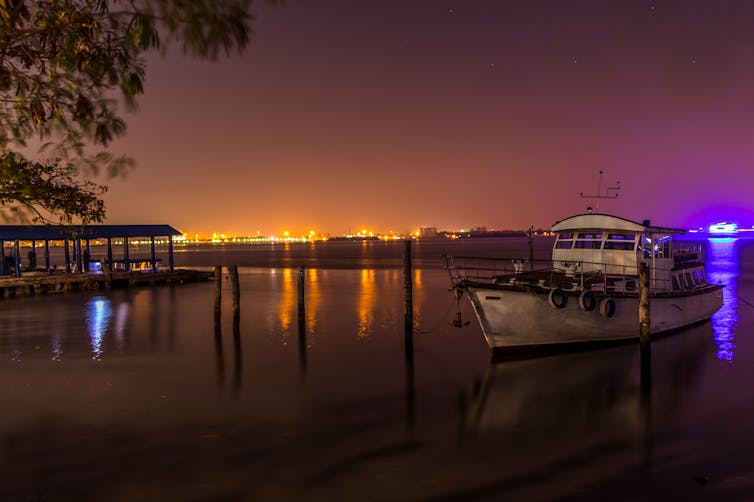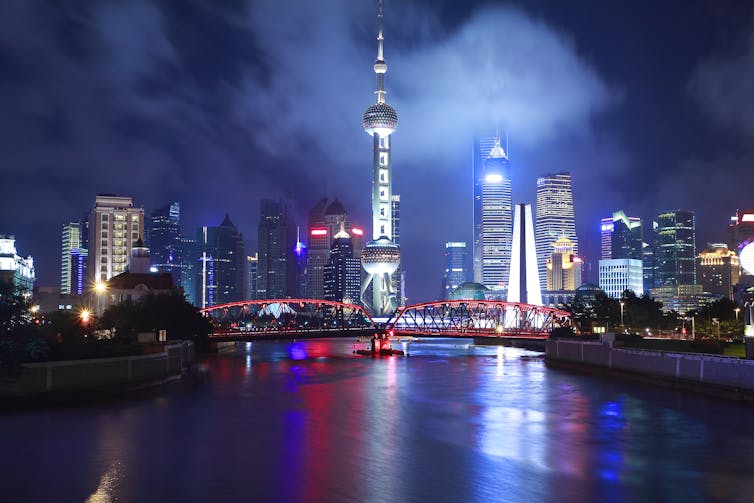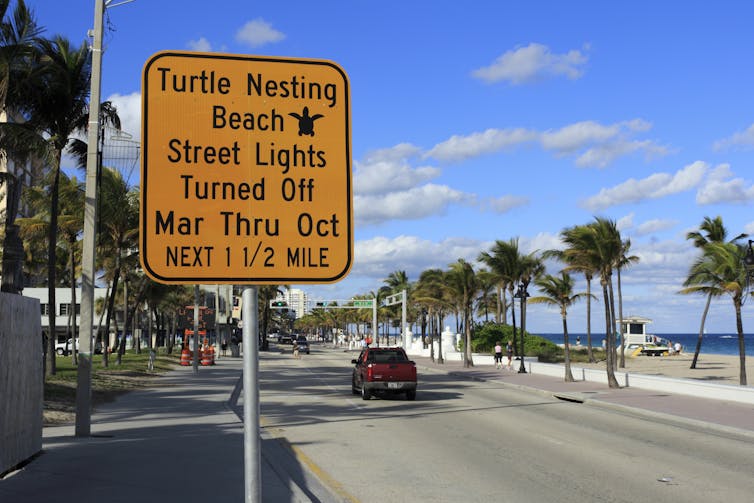Urban light pollution is a danger for marine ecosystems – new research

Cities are artificially lit to allow humans to make use of the night. This light pollution means that stars are often barely visible in urban skies. But reduced stargazing is not the only impact of artificial light at night.
Urban development in coastal areas is increasingly exposing marine ecosystems to artificial light. This exposure is particularly acute in and near some of the world’s largest coastal cities and may carry physiological and behavioural consequences for the organisms that inhabit their coastal waters.
The Plymouth Marine Laboratory, where I lead the Marine Biogeochemistry team, last year published an atlas of artificial light at night under the sea. The atlas reveals that at a depth of 1 metre, light pollution affects 1.9 million sq km of the world’s coastal seas. This is equivalent to 3.1% of global exclusive economic zones (the areas of the ocean owned by coastal nations).
Such research has confirmed that light pollution is widespread and expanding. But the difference between the intensity and cycles of natural and unnatural light has to this point been understudied. Quantifying this would allow a better understanding of the impact of expansive urbanised coastlines on the ecology of marine ecosystems.
Together with colleagues from the Universities of Plymouth and Strathclyde, we quantified the magnitude of the natural and unnatural light reaching the marine ecosystems of a group of seven coastal cities with more than 10 million inhabitants: Tokyo, Shanghai, Mumbai, New York, Buenos Aires, Lagos and Los Angeles.
Our research showed that for these cities, dosages of artificial light at night on the surface of the sea are up to six times greater than moonlight. Moonlight intensity only exceeded artificial lighting within a period of three days from the brightest full moons.

Illuminating coastal waters
Our model, which included inputs for lunar, artificial light and both daylight and twilight solar sources alongside seasonal and tidal changes in the distribution of light, was applied to each city over the course of 2020. In 15-minute time intervals we then determined the intensity of these light sources both above the sea’s surface and in the intertidal zone. This refers to the points on the shore which are covered, generally twice a day, by the tide.
We also applied the model to Plymouth, a coastal city in the west of England with a population of 230,000. Natural and artificial light sources have been studied here from 2001 to 2020 in order to capture the variability in tidal and lunar cycles. This fieldwork allowed us to ensure that our model provided accurate predictions.
In Plymouth, artificial light at night dosages generally ranked sixth across all of the cities studied. The city has a relatively northerly latitude, meaning it has long nights during the autumn and winter months. Yet summertime full moons in Plymouth shine with an intensity close to that of artificial light because the moon is close to the horizon all night with a longer atmospheric path length.
But the marine ecosystems likely to be most affected by light pollution are those in the coastal waters of Los Angeles, New York, Buenos Aires, Shanghai and Mumbai. Factors including tidal range and water clarity interact with the high intensity brightness of artificial urban lighting to impact marine ecosystems in these locations.
Impact on marine ecosystems
Natural sources of light at night have seasonal cycles. Nighttime light exposure has therefore historically been dependent on the moon and its cycle of waxing, waning and elevation in the sky. Artificial light sources, in contrast, have a fixed position irrespective of the season and shine with the same intensity throughout the night and all year round.
Scientific research has shown that light pollution can mask the natural cycle of the moon and can affect coastal organisms. This occurs at a variety of scales, from a hyperlocal (underneath street lights) to a regional and even global scale.
Marine organisms, including coral reefs, rely on natural light cycles to regulate their physiological and biological processes. Several coral species simultaneously release their reproductive cells – called gametes – on cues from the lunar cycle.
Key maintenance processes in coral, such as symbiosis, can also be sensitive to artificial lighting. Symbiosis describes the close relationship between the two organisms that make up coral.
The spectral composition of artificial light at night (its red, green and blue light components) illuminating seafloor habitats may also disrupt visually guided ecological processes. Predators that usually feed in the day such as the herring gull may be able to see prey that would ordinarily be camouflaged at night, such as marine snails.

Illuminating coastal environments can also alter the bodily functions of many marine animals. Exposure to artificial light can reduce the reproductive success of fish. And research has also found that it can disorientate turtle hatchlings and affect their ability to reach the safety of the ocean.
Some species are highly sensitive to even low levels of light. The daily migration of zooplankton, which are a key part of the marine food chain, can be disrupted by artificial light. Research in the Arctic has observed that zooplankton move away from the working light of a ship at depths of at least 200 metres.
Measuring light pollution in nature is a challenge because of the low intensities of light encountered. This is particularly true at greater depths.
But overcoming these challenges is essential to facilitate a better understanding of the ecological impact of light pollution. Research such as ours will guide biologists on future research into the impact of light pollution on marine ecosystems. It will also provide urban planners with the information necessary to balance coastal urban development with the protection of marine ecosystems.![]()
Tim Smyth, Head of Science: Marine Biogeochemistry and Observations, Plymouth Marine Laboratory
This article is republished from The Conversation under a Creative Commons license. Read the original article.
No comments:
Post a Comment